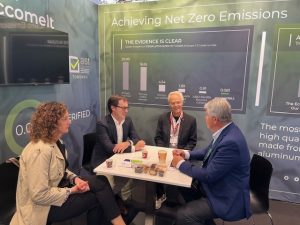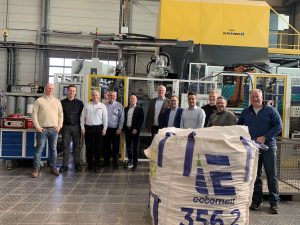On Tuesday, February 1, 2022, Eccomelt participated in the Sustainability Panel at the Platts Aluminum Symposium, together with representatives from Rio Tinto, Hydro and Constellium. Catherine Athenes, Vice President of Group Sustainability and Public Affairs (Europe) at Constellium, opened the panel with a presentation of the definitions of “green”, “sustainable”, “low carbon aluminum” and pointed out that there are no generally accepted definitions. She explained the Aluminum Stewardship Initiative’s view and definition of “sustainable” as well as the GHG Protocol Corporate Standard calculation method (3 scopes) of a corporate and product carbon footprint, the only truly quantifiable sustainability aspect currently. She also provided definitions for “cradle to grave”, “cradle to gate”, and “gate to gate”. Her clear elaboration of this topic is very important for those of us in the aluminum industry required to calculate the true carbon footprint of our products. Ms. Athenes gave several examples of Constellum’s customers (like automotive OEMs) who require the carbon footprint of their suppliers and their products. She explained that as an aluminum processor the only methods of reducing carbon footprint are to (1) maximize recycling, (2) use low-carbon primary aluminum if necessary, and (3) maximize the benefits of their products in the use phase (through innovations in light-weighting of the products they go into, such as cars). She also explained European policies and priorities when it comes to recycling and sustainability.
Rob Morgan, Director of Sales at Hydro, then explained that Hydro is offering primary grade aluminum with recycling content that helps reduce its carbon footprint, thereby showing Hydro’s commitment to recycling. He reiterated Constellium’s statement that we need to use more renewable energy for (low carbon) primary aluminum production and increase recycling and integration of post-consumer scrap into aluminum products to reinforce aluminum’s sustainability. Mr. Morgan then pointed out that while everybody agrees that post-consumer scrap starts with zero carbon footprint at the scrapyard, there is a clear lack of definition in the industry about carbon footprint in pre-consumer scrap. Hydro’s perspective is that it should retain the carbon footprint of the material and process it was made of (and have the same carbon footprint per lb as the product that was produced with this material and process). This point was later heavily discussed in the panel and all agreed that our industry needs a global standard on how to calculate the carbon footprint of in-process / pre-consumer scrap to avoid double-counting or no-counting. It is of course all about incentivizing the right behaviour: if in-process scrap is “burden free” (like post-consumer scrap) when it comes to carbon footprint, then there is a big incentive to recycle all of it. On the other hand, Morgan pointed out, making process scrap “burden free”could incentivize the production of unnecessary scrap simply to “free the metal of carbon footprint”. The other panel participants did not consider the above scenario to be a big risk, but rather said the IAI or Aluminum Association would simply need to define a standard so everybody calculates the same way.
Eccomelt’s Martin Hartlieb reinforced the need for exact calculation standards for in-process scrap, and pointed out that for the industry it is also very important to prevent “green washing” or publishing only partial (and hence incomplete) carbon footprint information. He explained the difference between the GHG Protocol Corporate Standard Scope 1 – 3 versus the IAI Level 1 – 3 calculation method (the latter is typically used for primary aluminum production). He pointed out that, while it is useful to compare primary aluminum smelter performance based on IAI Level 1, this number can be very confusing for aluminum processors and end users, as it is only Scope 1-2 of the aluminum smelter, not including the carbon footprint of the bauxite mine, alumina refinery, all the logistics, alloying elements, etc. He showed that even with low-carbon smelting, the carbon footprint originating from the rest of the value chain can be very significant. If primary producers only publish one number, it is often not clear whether this is only IAI Level 1 or actually the full carbon footprint. Mr. Hartlieb then explained the carbon footprint of Eccomelt and eccomelt356.2 and how it compares to other types of aluminum (A356 ingots).
The last presenter was Paramita Das from Rio Tinto, who explained Rio Tinto’s “Path to Net-Zero”. She explained the advantages of being an integrated aluminum company and what efforts Rio Tinto is making to be sustainable and offering customers traceability and transparency through latest block-chain technology. In her presentation, Ms. Das stated that Rio Tinto’s aluminum was “carbon free”, or “zero carbon through the full life cycle of production”. After listening to Catherine and Rob, we can assume that Ms. Das was solely referring to the ELYSIS metal. Even for ELYSIS, the term “zero carbon footprint” would only be correct for Level





